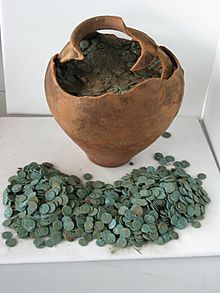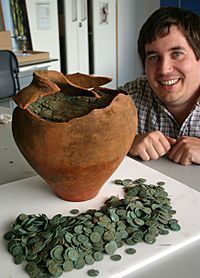Shrewsbury Hoard facts for kids
Quick facts for kids Shrewsbury Hoard |
|
|---|---|

Pot and coins from the hoard
|
|
| Material | Bronze |
| Size | 9,315 coins |
| Created | Mid-4th century |
| Period/culture | Romano-British |
| Discovered | Near Shrewsbury, Shropshire, by Nic Davies in August 2009 |
| Present location | British Museum, London |
The Shrewsbury Hoard (also called the Shropshire Hoard) is a huge collection of 9,315 bronze Roman coins. A person using a metal detector found them in a field near Shrewsbury, Shropshire in August 2009. The coins were inside a large pottery jar. This jar was buried around the year AD 335.
Contents
How the Hoard Was Found
The coins were found buried in a brown pot. This pot was in a wooded area next to a public walking path. Nic Davies found them just one month after he started metal detecting as a hobby. This was his very first discovery!
At first, Nic did not know he needed permission from the landowner to search for things. When he found the pot, he dug it up himself. Later, he showed it to Peter Reavill. Peter is a special officer who helps record old finds in the area.
Digging Up the Treasure
Nic then led Peter and archaeologists from Shropshire County Council to the spot. They carefully dug up the area. They learned that the pot was probably buried partly full of coins around AD 320. Later, more coins were added between AD 333 and 335. Then, a large stone was placed over the pot.
The top of the pot had broken off. About 300 coins were found scattered around the main spot. The pot and all the coins together weighed about 32 kilograms (70 pounds). After the digging was done, the hoard was sent to the British Museum in London. There, experts cleaned and preserved the coins.
What Was Found in the Hoard?
The Shrewsbury Hoard contains 9,315 coins. All of them are made of bronze or bronze coated with silver. These coins are called nummi. They were made between AD 313 and 335. This was during the later part of the rule of Emperor Constantine I. It also includes coins from when his three sons, Constantine II, Constantius II, and Constans, ruled together. A few older coins, called radiates, from AD 260–293 were also found.
Other Interesting Items
Besides the coins, an iron nail and a piece of cloth were found at the bottom of the pot. It is very rare for old cloth to survive for so long! The copper from the coins helped stop the cloth from decaying. Experts think the cloth might be what's left of a bag. This bag might have been closed with the nail. It's also thought that these items might have been placed with the coins as a special offering.
Why the Hoard Is Important
Even though each coin in the hoard is not worth a lot by itself, the huge number of coins makes this discovery very important. Peter Reavill, the officer who helped with the find, has an idea about why the coins were buried.
During the time of Emperor Constantine I, Britain grew a lot of food. This food was sent to other parts of the Roman Empire. Peter thinks these coins might have been payment to a farmer or a farming group for their harvest. The money might have been buried to keep it safe. People could then take out money when they needed it.
Displaying the Treasure
On October 25, 2011, a special hearing called a coroner's treasure inquest took place. This hearing officially declared that the coins were "treasure" under a law called the Treasure Act 1996.
The hoard will be valued by a committee. A reward will then be paid to the person who owns the land and the person who found the treasure. Usually, the value of the hoard is split equally between the landowner and the finder. However, if the treasure was found without permission to search on the land, the finder might get less money or no money at all. This shows why it's important to always get permission before metal detecting.
The Shropshire County Council Museum Service has bought the hoard. They plan to put it on permanent display at the Shrewsbury Museum.


